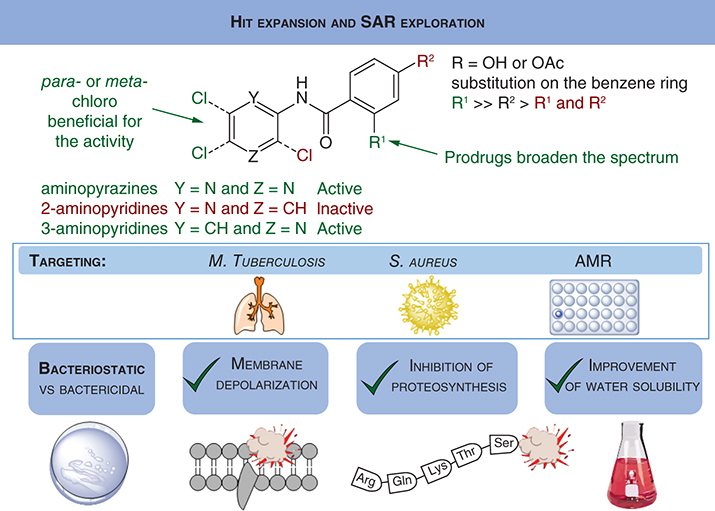Abstract
Background: The development of novel antimicrobial drugs is an essential part of combatting the uprising of antimicrobial resistance. Proper hit-to-lead development is crucially needed. Methods & results: We present a hit-expansion study of N-pyrazinyl- and N-pyridyl-hydroxybenzamides with a comprehensive determination of structure–activity relationships. The antimicrobial screening revealed high selectivity to staphylococci along with antimycobacterial activity with the best value of 6.25 μg/ml against Mycobacterium tuberculosis H37Rv. We proved an inhibition of proteosynthesis and a membrane depolarization of methicillin-resistant Staphylococcus aureus. Conclusion: Our results are a good starting point for further development of new antimicrobial compounds, where the next step would be tuning the potential between relatively nonspecific membrane depolarization effect and specific inhibition of proteosynthesis.
Graphical Abstract

Supplementary data
To view the supplementary data that accompany this paper please visit the journal website at:www.tandfonline.com/doi/full/10.2217/epi-2016-0184
Author contributions
M Kerda, P Šlechta and J Zitko designed the study. M Kerda and P Šlechta synthesized and purified the title compounds. O Janďourek, K Konečná and P Paterová performed the biological assays. P Hatoková performed solubility measurement. J Zitko performed in silico calculations. M Kerda, P Šlechta and J Zitko wrote the paper. All the authors have read and agreed to the published version of the manuscript.
Acknowledgments
The authors thank I Dufková and J Vacková for the antibacterial and antimycobacterial evaluations. Computational resources were supplied by the project “e-Infrastruktura CZ” (e-INFRA CZ LM2018140) supported by the Ministry of Education, Youth and Sports of the Czech Republic.
Financial & competing interests disclosure
This research was funded by the Ministry of Health of the Czech Republic, grant no. NU21-05-00482, by Charles University project SVV 260 666 (Czech Republic), and by “The project National Institute of Virology and Bacteriology (Programme EXCELES, ID project no. LX22NPO5103) – Funded by the European Union – Next Generation EU.” The authors have no other relevant affiliations or financial involvement with any organization or entity with a financial interest in or financial conflict with the subject matter or materials discussed in the manuscript apart from those disclosed.
No writing assistance was utilized in the production of this manuscript.
